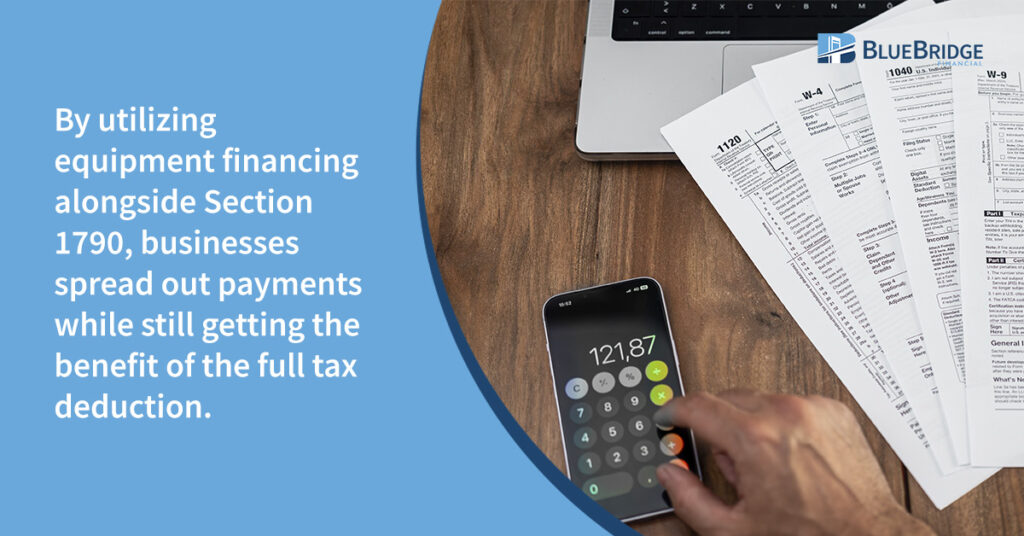What is Section 179 and how does it benefit small business owners?
Take Advantage of Section 179: A Tax Break That Means Business
As the end of the year approaches, there’s no better time for small business owners to take advantage of Section 179 for substantial tax savings while acquiring new equipment. This provision of the IRS tax code allows business owners to deduct the full purchase price of qualifying equipment bought or financed before the year ends, making it an ideal opportunity to invest in the tools needed for growth and expansion.
Instead of spreading expenses over several years, small business owners can enjoy a significant tax deduction immediately, effectively reducing their taxable income. In this blog, we’ll explore the key aspects of Section 179, including an overview of its benefits for small businesses, how it provides immediate tax savings to enhance cash flow, strategies for maximizing equipment financing, the types of eligible equipment you can deduct, and ways to leverage Section 179 for future growth. Whether you’re considering investing in new equipment or just looking to understand your options, this guide will help you make the most of this valuable tax benefit.
Understanding Section 179: An Overview for Small Businesses
Section 179 has become an essential provision for small businesses looking to invest in their future. Originally designed to facilitate the acquisition of equipment, this tax code allows business owners to deduct the full purchase price of qualifying equipment and software in the year it is placed into service. This encourages small businesses to upgrade their tools and technology without the burden of waiting for long-term depreciation.
Definition and Purpose
At its core, Section 179 allows businesses to treat the cost of certain assets—like machinery, equipment, and software—as an immediate expense rather than a long-term investment. When a business capitalizes an asset, it spreads the cost over several years through depreciation. However, with Section 179, businesses can deduct the entire purchase price in the year they buy or finance the asset. This means small businesses can reduce their taxable income more quickly, leading to immediate tax savings rather than waiting for the expense to be recognized over time.
The primary purpose of Section 179 is to incentivize business owners to invest in their businesses. By allowing immediate tax relief, it helps to stimulate growth and innovation. This is particularly important in competitive industries where having the right tools can make a significant difference in productivity and efficiency.
To qualify, equipment must be purchased or financed and placed into service within the tax year—specifically, by December 31st. It’s crucial to ensure that any necessary installations or integrations are completed on time, so businesses should coordinate closely with vendors to meet these deadlines. This proactive approach can lead to considerable tax savings and enhanced operational capabilities.
In addition, there are limits on the total amount that can be written off.
- For tax year 2024, the cap amount is $1,220,000.
- This limit is reduced by the amount by which the cost of section 179 property placed in service during the tax year exceeds $3,050,000.
- The maximum section 179 expense deduction for sport utility vehicles placed in service in tax years beginning in 2024 is $30,500.

Immediate Tax Savings: Boosting Cash Flow with Section 179
By reducing taxable income, businesses can retain more of their earnings, improving cash flow and providing additional funds for reinvestment or operational expenses. The immediate tax savings from Section 179 can be used to expand operations, or cover other critical business needs, offering greater financial flexibility in the short term.
Maximizing Equipment Financing with Section 179
Combining equipment financing with Section 179 amplifies the benefits by allowing businesses to spread out payments over time while still taking advantage of the full tax deduction in the year of purchase, optimizing both cash flow and tax savings. This also reduces the effective cost of equipment via tax savings, making it easier to justify and manage larger purchases.
Equipment acquired through financing agreements can still qualify for the deduction, allowing businesses to benefit from Section 179 without large upfront costs. You can learn more about the benefits of equipment financing in our “Equipment Financing Basics” blog post.

Eligible Equipment: What Small Businesses Can Deduct
With the potential benefits of Section 179 in mind, it’s important to understand what types of equipment qualify for the deduction. Equipment must be used for business purposes over 50% of the time and should be considered essential to the operation of your business.
Both new and used equipment, either purchased or finances, can qualify for Section 179 deduction.
Qualifying equipment can include:
- Machinery
- Equipment
- Vehicles
- Office Furniture
- Computers
- Software
Equipment across many different industries are eligible for Section 179, including construction vehicles, manufacturing tools, and transportation equipment.
Strategic Planning: Leveraging Section 179 for Future Growth
It’s important not to overlook the power and potential of Section 179 deductions to enable your business to strategically plan equipment acquisitions that maximize tax benefits. We encourage you to consult with your accountant or tax advisor for specific advice and how to approach this for your business.
Recent data from the NFIB showed 78 percent of small businesses used Section 179 to offset their tax expenses. Despite its seemingly universal appeal it is important to know this benefit may not be around forever. As it is currently written, the bonus depreciation deduction is phasing out 20% per year, with a projected sunset after the end of the 2026 calendar year. This means acting sooner could make a significant impact on your business today and in the long term.
Working with financing partners like Blue Bridge Financial can help businesses acquire the funds they need to secure new equipment for their business. Coupled with Section 179, small business owners can optimize both tax savings and capital investment for sustained growth.
Real-World Impact: Section 179 Tax Savings for Small Businesses
Utilizing Section 179 can be transformative for small businesses looking to invest in equipment while maximizing tax savings. Here’s a quick example to show the deduction’s impact:
Example Calculation: For a small business that invests $100,000 in qualifying equipment, applying the Section 179 deduction allows the entire purchase amount to be deducted in the year of purchase. For a company in the 21% tax bracket, this results in a tax savings of $21,000, effectively lowering the after-tax cost of the equipment to $79,000. If the business is in a higher bracket, savings can increase to as much as $37,000. This immediate deduction provides significant cash flow benefits, making it easier for businesses to reinvest savings into other growth areas.
Case Study Example: Consider a manufacturing business that invests $200,000 in new machinery. By utilizing Section 179, the company deducts the entire amount in the first year, reducing its taxable income by $200,000. If the business falls in the 24% tax bracket, this results in a $48,000 tax saving. The immediate tax break improves cash flow and offsets some initial equipment costs, resulting in faster ROI on machinery through increased production efficiency.
By providing immediate tax relief, Section 179 enables businesses to accelerate ROI on critical equipment purchases, thus supporting operational efficiency and growth potential
About Blue Bridge Financial
Blue Bridge Financial is a specialty equipment finance firm providing small and medium-sized businesses with secured loans for revenue-producing, essential-use equipment. We serve a wide range of industries, including Manufacturing, Agricultural, Construction, and Medical. To learn more about our Equipment Finance Agreements and the potential for tax advantages including Section 179, contact us to get started today.
Are you looking to acquire equipment specifically for a manufacturing business? Be sure to read our recent blog post on the top five key pieces of manufacturing equipment you can finance to upgrade your business. Utilizing these tools alongside the advantages of Section 179 can be a wise business decision.
Disclaimer: This material is not intended to provide, and should not be relied on for, tax, legal or accounting advice. Consult with your CPA or Tax Advisor to determine applicability to your specific equipment purchase and business situation.
Frequently Asked Questions About Section 179 Tax Deductions
Section 179 is a tax deduction that allows small businesses to write off the full purchase price of qualifying equipment and software in the year they purchase it. Instead of depreciating the cost over several years, businesses can deduct the full expense, which reduces their taxable income.
Most tangible business equipment qualifies, including machinery, vehicles, computers, and office furniture. Additionally, software and some business property improvements, like HVAC systems or security, may qualify if they meet Section 179 requirements.
For 2024, the maximum deduction limit is $1,160,000, with a spending cap of $4,050,000 on qualifying equipment. These limits are adjusted annually, so it’s essential to check for the most current information each tax year.
In 2025, the maximum Section 179 deduction limit will be $1,220,000, and the threshold for total eligible equipment purchases will be $3,050,000.
Yes, used equipment often qualifies for Section 179 as long as it’s new to your business and meets the IRS requirements. Many small businesses save significantly by applying Section 179 to purchases of pre-owned equipment.
To qualify for a Section 179 deduction, businesses must purchase, finance, or lease qualifying equipment and place it into service by December 31 of the tax year. This makes timing crucial for those looking to leverage Section 179 benefits within the current tax year.
Any Questions? We'd Love to Talk:
About the Author
Nick Devernis is the Vice President of Business Development with expertise in credit analysis and equipment financing. With over 6 years in equipment financing, he offers a wealth of knowledge to readers of Blue Bridge Financial’s blog. He currently oversees the California office and leads the Sales and Marketing departments. Nick’s role as Vice President of Business Development involves management of the sales team, relationship management, and developing strategic partnerships to drive inbound and outbound originations.p> LinkedIn Profile






